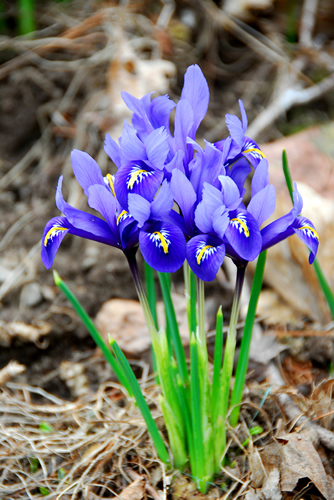Contents:
Common Names | Parts Usually Used | Plant(s) & Culture | Where Found | Medicinal Properties
Legends, Myths and Stories | Uses | How Sold | Warning | Bibliography
Scientific Names

- Iris X Germanica var. Florentina
- Iridaceae
- Iris family
Common Name
- Florentine iris
Parts Usually Used
Rootstock
Back to Top
Description of Plant(s) and Culture
Orris root is the rootstock of the Florentine iris. It has the typical erect, basal, sword-like leaves. The flowers are white with blue veins, violet scented, the outer divisions fringed with yellow. Flowering time is from March through July.
Plant likes full sun in deep, rich, well-drained soil. Harvest rhizomes in late autumn.
Orris is obtained from 3 varieties of garden Iris known botanically as Iris Germanica, Iris pallida, and Iris Florentina.
Back to Top
Where Found
Grows in the Mediterranean countries.
Back to Top
Medicinal Properties
Diuretic, stomachic.
Back to Top
Legends, Myths and Stories
Orris root is native to Asia Minor, the Balkans, and Italy.
The dried rhizomes have been used by herbalists for many centuries. Fresh, the rhizomes have little odor, but dried, they have a sweet scent of violets. The characteristic violet odor is gradually developed during the drying process and does not attain its maximum fragrance for at least 2 years. Used years ago to keep linen, blankets, wardrobes, chests, etc., fresh and smelling sweet. Orris has been used as the main ingredient in almost all the old-fashioned face powders, foot powders, sachet powder, dental creams, violet scented soaps and cosmetics, and pot-pourri.
Whole roots of Orris, resembling the human form, are used in voodoo performances and the powdered root is an ingredient in “love potions.”
Back to Top
Uses
Orris root is used in treatment of dropsy and other water retention problems. It is also used sometimes for bronchitis, coughs, and sore throat; for colic; and for congestion in the liver. Relieves shortness of breath, resists poisoning, starts menses as a uterine stimulant, and reduces bruises if used externally.
Back to Top
How Sold
Commercial production of orris root is centered in Florence, Italy.
Back to Top
Warning
Do not use during pregnancy, it is a uterine stimulant.
Back to Top
Bibliography
Herbal Gardening, compiled by The Robison York State Herb Garden, Cornell Plantations, Matthaei Botanical Gardens of the University of Michigan, University of California Botanical Garden, Berkeley., Pantheon Books, Knopf Publishing Group, New York, 1994, first edition
![]() Culpeper’s Complete Herbal & English Physician: Updated With 117 Modern Herbs
Culpeper’s Complete Herbal & English Physician: Updated With 117 Modern Herbs, by Nicholas Culpeper, Meyerbooks, publisher, PO Box 427, Glenwood, Illinois 60425, 1990, (reprint of 1814)
![]() The Herbalist Almanac
The Herbalist Almanac, by Clarence Meyer, Meyerbooks, publisher, PO Box 427, Glenwood, Illinois 60425, copyright 1988, fifth printing, 1994
![]() Webster’s New World Dictionary
Webster’s New World Dictionary, Third College Edition, Victoria Neufeldt, Editor in Chief, New World Dictionaries: A Division of Simon & Schuster, Inc., 15 Columbus Circle, New York, NY 10023
 The Rodale Herb Book: How to Use, Grow, and Buy Nature’s Miracle Plants (An Organic gardening and farming book)
The Rodale Herb Book: How to Use, Grow, and Buy Nature’s Miracle Plants (An Organic gardening and farming book), edited by William H. Hylton, Rodale Press, Inc. Emmaus, PA, 18049., 1974
